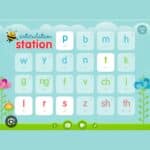In our increasingly digital world, parents are constantly exploring new tools to foster their child’s development. For individuals experiencing speech and language delays, apps may be a promising tool. This article explores the potential benefits and pitfalls of app usage, offering you a roadmap to navigate this domain effectively. It will answer the question, “Can apps help speech and language development?”
Advantages of Using Apps to Help Children with Speech and Language Delays
Engaging and Interactive Learning
The vibrant visuals, captivating audio, and hands-on elements in apps can instantly grab a child’s interest, ensuring they’re not just observing but actively participating in their learning journey.
Allow for Targeting and Practice of Specific Skills
Apps aren’t meant to replace face to face, hands-on, or professional interventions but to complement and reinforce them. They can be used to target a specific skill such as articulation, vocabulary development, direction following, comprehension, and so much more. Apps can make practice sessions at home more enjoyable and effective.
Customization
The beauty of many educational apps lies in their adaptability. Parents can modify settings, calibrating the content to align with their child’s current abilities and growth trajectory. Some apps can also be used to monitor progress.
Accessibility
With a learning tool right in your pocket, consistency becomes effortless. Whether at a doctor’s waiting room or on a long drive, learning can be nurtured easily.
Can Provide a Means of Augmentative or Alternative Communication (AAC)
There are many apps at varying levels of complexity that can be used as a means of Augmentative or Alternative Communication. Some of these apps offer the same software features as the software on a dedicated AAC device at a fraction of the cost.
Disadvantages of App Usage
Over-Reliance and Risk of Isolation
An over-reliance on screens might curtail the invaluable face-to-face and hands-on interactions that are critical for speech, language, and communication acquisition and overall development.
Lack of Physical Activity
Excessive use of screens may interfere with the physical activity children require to learn and remain healthy and fit.
Potential for Distractions
While apps can be educational, they might also divert a child’s attention away from social interaction and human to human learning experiences.
Safety and Privacy Concerns
It’s essential to ensure apps have robust privacy settings, so children aren’t inadvertently exposed to inappropriate content or potential cyber threats.
Exploring App Categories
Apps Designed to Improve Speech, Language, and Cognitive Skills

Example: Articulation Station – This app uses modeling, imitation, repetition, and feedback to support consonant sound development, production, accuracy, and practice.

Example: Starfall -This app offers a broad variety of fun learning activities to support language development, preschool readiness, literacy, math, music, social-emotional development, and more. Designed for developmental levels from preschool through fifth grade.
Augmentative and Alternative Communication (AAC) Apps
Example: TouchChat and Proloquo2Go – Designed for children who have difficulty speaking, these apps are allow users to select photos, pictures, or symbols and in turn, the app speaks the words, phrases, and sentences they have chosen. These apps can turn a tablet computer into a sophisticated and effective communication AAC device.
Selecting the Right App for Your Child
Read the Reviews and Ratings
While the app’s overall rating provides some insights, reading reviews, especially from parents in similar situations, can be enlightening.
Get Free Samples:
Many apps offer a free sample or lite version. Review these before investing to determine their alignment with your child’s needs, learning style, and interests.
Seek Professional Insights
Speech-language pathologists and educators often have a list of tried-and-tested apps that they recommend. Their advice can be gold.
Parental Involvement: Boosting the App Experience
Designated Shared Sessions
Sit down with your child and interact with them during their app time. This shared experience not only strengthens your bond and enriches learning outcomes but also provides you with firsthand insights into their strengths, areas needing more practice, and progress.
Merging Digital and Real Worlds
Encourage your child to use and apply newly acquired words, knowledge, or concepts from the apps in day-to-day conversations, bridging the gap between app-based and real-world learning.
Setting Healthy Boundaries
Time Management
It’s crucial to set time limits for app usage to prevent overreliance on screens, perseverative behaviors, social separation, and dependency.
Screen Time Recommendations by the American Academy of Pediatrics
- Infants 18 months and younger: Screen time isn’t recommended, except for video chatting.
- Toddlers 18 to 24 months: Limited screen time with high-quality programming, always with adult participation and guidance.
- Preschool children (2-5 years): 1 hour per day of parent-child co-viewed guided screen time.
- Children 6 years and older: Consistent limits on the time and type of media consumed.
A Diverse Learning Palette
While apps are a potent tool, ensure your child’s day also includes a majority of time devoted to offline learning, unstructured and structured playtime, physical activity, and face to face social interactions.
If a child is using an app for communication purposes, the app and tablet computer should be accessible to them during all communication situations.
The Pitfalls of Overdependence
Merely relying on apps to support your child’s learning and development can restrict your child’s exposure to varied learning opportunities and first-hand language interactions. Balancing tech-based learning with authentic real-life experiences is the key to holistic development.
Tips for Parents
- Routine Integration: Embed app sessions into the daily routine, perhaps as a pre-lunch or post-nap activity.
- Model, Model, Model: Demonstrate the use of the app for your child.
- Celebrate Progress: Recognize and celebrate app-based efforts and accomplishments, bolstering your child’s motivation to learn.
- Community Bonding: Engage with offline and online parent communities to exchange app recommendations and experiences.
FAQs
- Should educational apps be the centerpiece of learning?
- No. Educational apps should supplement and reinforce, not replace, traditional face to face learning, interaction and therapy.
- Can children without speech delays benefit from these apps?
- Yes! They can enrich vocabulary, pronunciation, communication, and so much more.
- How can I assure my child’s online safety?
- Employ parental controls, routinely exercise co-viewing, scrutinize app content, and monitor internet access.
- Are premium apps worth the investment?
- Often, they offer a more enriched, ad-free experience. Assess them carefully before making an investment.
Resources
- Joint Parent-Child App Play Can Bolster Language Development: SLPs can show parents how to harness apps to get their children talking at home.: The ASHA Leader: Vol 22, No 4
- What do we really know about kids and screens? (apa.org)
- Can Toddler Screen Time Be Educational? | Child Mind Institute
- A Research-Backed Guide to Educational Apps for Children | Psychology Today
- When to Introduce Screens to Children – those media moms
- Selecting Apps to Support Children’s Learning | NAEYC
Conclusion
While apps present a formidable opportunity to nurture your child’s speech, language, and communication skills, it’s important to use them judiciously. Marrying the right digital tools in a parent-child learning experience with real-world hands-on experiences can pave the way for a well-rounded communication foundation and growth.




0 Comments